What Influenced Art During the Renaissance What Affected Art During the Renaissance
The Renaissance was maybe the nigh important menstruation of development that has ever occurred in European history. Known primarily for its bear on on the art world, the Renaissance emerged as a movement that influenced literature, philosophy, music, science, and even technology. With the impacts of the Renaissance still felt in society today, it unquestionably remains 1 of the most spoken-about and celebrated movements in both the creative and general customs.
Table of Contents
- 1 An Introduction to the Renaissance
- 2 Interesting Facts About the Renaissance
- 2.1 The Renaissance Began in the 14th Century
- 2.ii The Renaissance Period Transformed Society from Darkness to Light
- 2.three Humanism Was the Main Philosophy
- ii.4 The Medici Family Were Major Patrons of the Movement
- ii.v The Height of the Renaissance Was Chosen the "High Renaissance"
- 2.6 Paintings, Drawings, and Sculptures Were the Main Art Forms That Emerged
- 2.7 Leonardo da Vinci Was Viewed as the Ultimate "Renaissance Man"
- 2.viii The Renaissance Lasted for Four Centuries
- two.ix The Term "Renaissance" Was French
- 2.10 The Renaissance Is Regarded every bit the Nigh Important Art Motility to Occur
- ii.11 Art, Architecture, and Science That Developed
- 2.12 The Renaissance Geniuses Included Art History'southward Most Famous Artists
- 2.13 The Nigh Famous Paintings Are Still Viewed Today
- two.14 Some Have Stated that the Renaissance Did Not Fifty-fifty Happen
- ii.15 Linear Perspective Was the Most Important Invention of the Movement
- 2.xvi The Church building Financed Great Renaissance Artworks
- 2.17 A Great Rivalry Existed Betwixt Michelangelo and Leonardo da Vinci
- two.18 The Renaissance Was Not Always as Wonderful as History Suggests
- 3 Ofttimes Asked Questions
- 3.one What Is the Most Valuable Painting From the Renaissance?
- 3.2 What Is the Most Valuable Sculpture From the Renaissance?
An Introduction to the Renaissance
Most strongly associated with the Italian metropolis of Florence specifically, the Renaissance describes the flow of time between the fourteenth and 17th centuries. Thought of as the bridge that connected the Center Ages with Modernistic history, the Renaissance initially began as a cultural movement during the Late Medieval period in Italy. However, information technology rapidly dispersed all over Europe. Due to this, about other European countries experienced their own version of the Renaissance in terms of their styles and ideas.
Seen primarily as a painting, sculptural, and decorative arts period, the Renaissance emerged as a distinctive mode within fine art alongside other important cultural developments which were occurring in those days.
 Thou staircase ceiling of Kunsthistorischen Museum in Vienna, with Apotheosis of the Renaissance (1888) fresco made by Mihály Munkácsy; Kunsthistorisches Museum, CC By-SA four.0, via Wikimedia Commons
Thou staircase ceiling of Kunsthistorischen Museum in Vienna, with Apotheosis of the Renaissance (1888) fresco made by Mihály Munkácsy; Kunsthistorisches Museum, CC By-SA four.0, via Wikimedia Commons
As the movement affected political and economic spheres in addition to civilisation and art, those who upheld the concepts of the Renaissance were thought to do so with much passion. The Renaissance used the art of Classical antiquity as its base and slowly began to build upon the ideologies of that style as the movement avant-garde.
As there is and then much information out there on the Renaissance, it is withal easy to go confused and wonder: what was the Renaissance? Essentially, it can be described as a noble style of art that rapidly developed under the growing contemporary scientific and cultural knowledge that existed.
Thus, the Renaissance is recognized for initiating the change into the modern-day civilization that we know today, with many of history'south greatest thinkers, authors, philosophers, scientists, and artists coming from this era.
Interesting Facts About the Renaissance
When looking at the overall Renaissance history, the movement proved to exist a very interesting one in addition to its being so historic. Below, nosotros will exist taking a look at some of the more fascinating and agreeable Renaissance facts from the almost noteworthy artistic catamenia in fourth dimension.
The Renaissance Began in the 14th Century
Emerging around 1350 A.D., the Renaissance period began roughly 720 years ago when people in Europe began taking a renewed involvement in the ancient Roman and Greek civilizations and cultures. The Renaissance motility looked to restore the ideas, art styles, and learning of these two cultures and aptly viewed the period to be a restoration of these concepts.
Thus, the movement was given the name "the Renaissance", which is the French word for "rebirth".
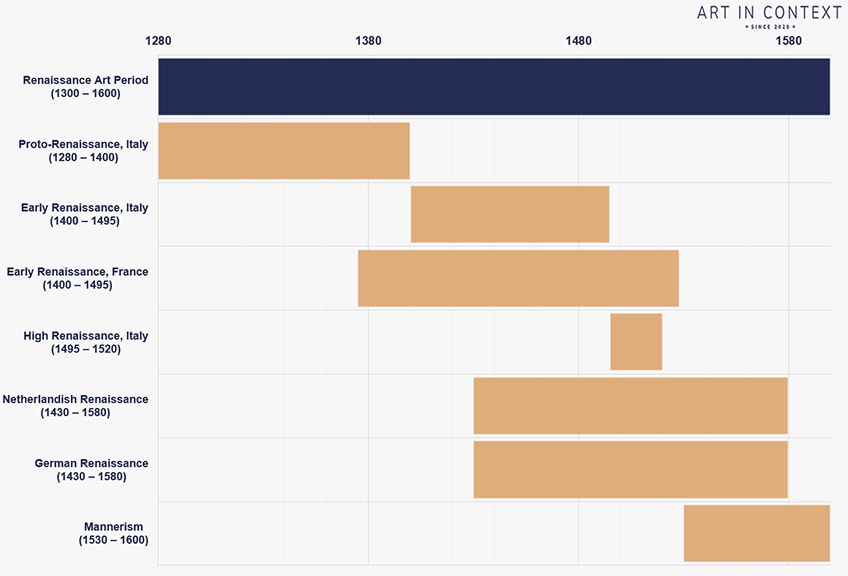
Lasting for over 250 years, scholars were encouraged by wealthy families in Italy to focus their studies on ancient Greek and Roman cultures specifically. As the affluent class were so overwhelmed and amazed by the ethics of these old cultures, they began to finance the creation of magnificent palaces that were filled with paintings, sculptures, and literature that upheld these values. The metropolis of Florence proved to be one of the most important regions during the Italian Renaissance, every bit about celebrated artworks originated from this region.
The Renaissance flow quickly spread to other parts of the world, well-nigh notably to other countries in Europe.
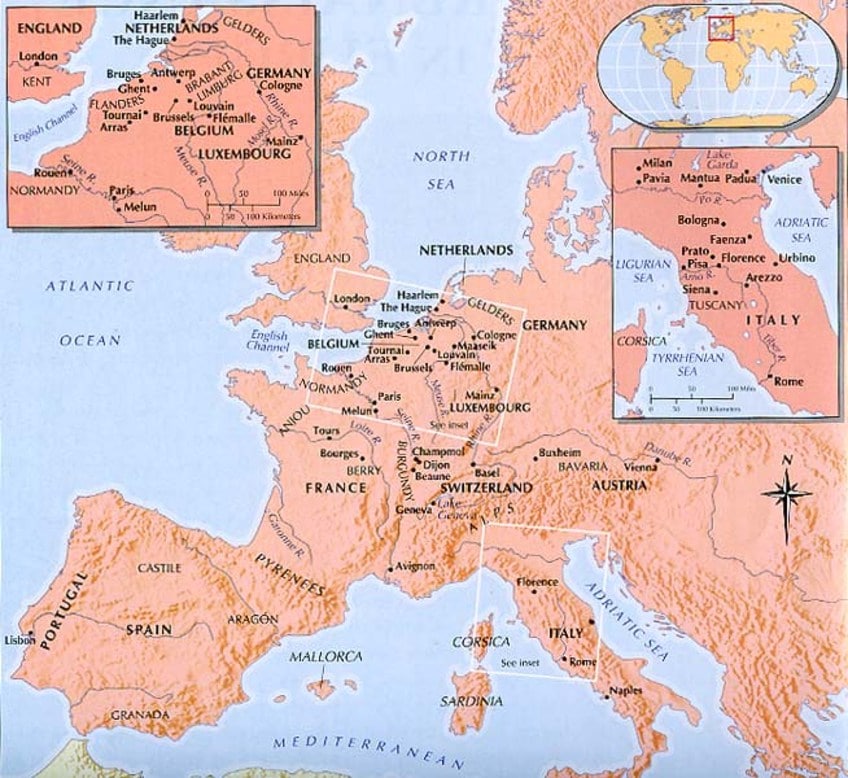 Map of Italian and Northern Renaissance cities;Bljc5f, CC Past-SA 4.0, via Wikimedia Commons
Map of Italian and Northern Renaissance cities;Bljc5f, CC Past-SA 4.0, via Wikimedia Commons
After the King of France, Charles Eight, stormed Italy and saw the truly breathtaking artworks that had been created, he invited several Italian artists to France to spread their ideas and to produce as beautiful works for the country.
Other countries like Poland and Hungary likewise welcomed the Renaissance mode afterward Italian scholars and artists went to alive there.
Equally the Renaissance expanded beyond different countries, the movement went on to alter some aspects of religion and art through the values it brought over. Certain countries that the Renaissance wave proved to have an influential impact on included Germany, Espana, Portugal, England, Scandinavia, and Key Europe.
The Renaissance Period Transformed Lodge from Darkness to Low-cal
Over the class of the Middle Ages in Europe, which occurred between the collapse of aboriginal Rome in 476 A.D. and the start of the fourteenth century, non much advancement happened in scientific discipline and fine art. Due to this lack of progress, this period in time was literally dubbed "the Dark Ages", which spoke to the gloomy atmosphere that had settled over Europe.
As this era was marked equally a time of state of war, other issues such as ignorance, famine, and the Black Expiry pandemic added to the period'due south dreary title.
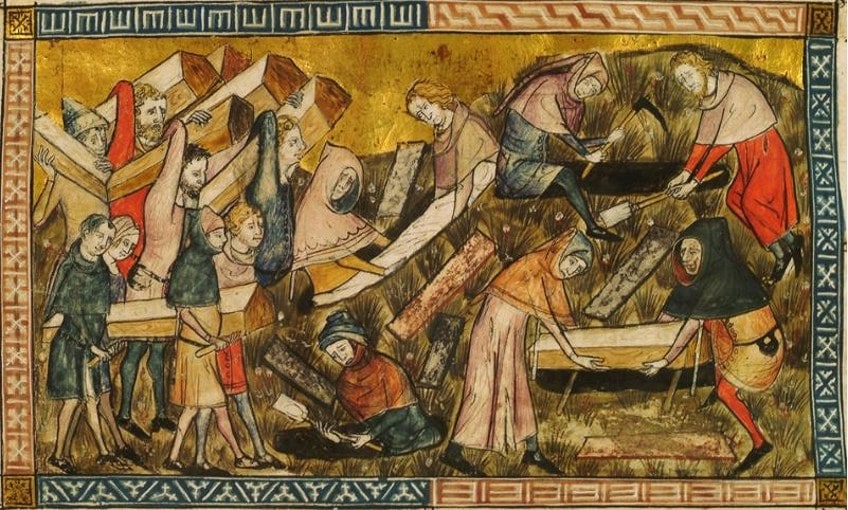 Miniature by Pierart dou Tielt illustrating the people of Tournai burying victims of the Blackness Decease, c. 1353; Pierart dou Tielt (fl. 1340-1360), Public domain, via Wikimedia Commons
Miniature by Pierart dou Tielt illustrating the people of Tournai burying victims of the Blackness Decease, c. 1353; Pierart dou Tielt (fl. 1340-1360), Public domain, via Wikimedia Commons
Every bit the Dark Ages proved to exist a dismal fourth dimension in history, many take wondered: how did the Renaissance kickoff amid these treacherous conditions? Accurately described equally a motion that genuinely went "from darkness to light", the Renaissance reintroduced elements of aboriginal cultures that were able to help start the transition into the classical and mod period.
In addition to being seen as i of the virtually meaning periods in world history, the Renaissance is likewise regarded as one of the showtime influential turning points that occurred.
Even so, some historians accept argued that the Center Ages were not near every bit grim every bit what they were made out to be, equally information technology was suggested that virtually of the period was very exaggerated. Despite this difference in opinion, many accept agreed that relatively limited attention was paid towards ancient Greek and Roman philosophies and learning in those days, no matter the true circumstances that surrounded the Dark Ages. This was because society had much greater problems to focus on, with the aspects of fine art and science not seeming as of import yet.
 Armed forces and religious life in the Center Ages and at the period of the Renaissance (1870), Fig 42: "After the Battle of Hastings (14th Oct 1066), the relatives of the vanquished came to carry abroad their dead.";Internet Archive Volume Images, No restrictions, via Wikimedia Commons
Armed forces and religious life in the Center Ages and at the period of the Renaissance (1870), Fig 42: "After the Battle of Hastings (14th Oct 1066), the relatives of the vanquished came to carry abroad their dead.";Internet Archive Volume Images, No restrictions, via Wikimedia Commons
Humanism Was the Main Philosophy
The spirit of the Renaissance was initially expressed by a cultural and philosophical movement called humanism, which adult during the xivth century. Chop-chop gaining momentum, humanism referred to a method of education and mode of inquiry that began in Northern Italia before spreading to the rest of Europe. Humanism encompassed all teachers and students who belonged to the humanities schoolhouse of thought that included grammer, rhetoric, poetry, philosophy, and history.
Humanism centered around its emphasis on an individual's social potential and agency. This way of thinking viewed human beings every bit a worthwhile foundation for significant moral and philosophical investigation.
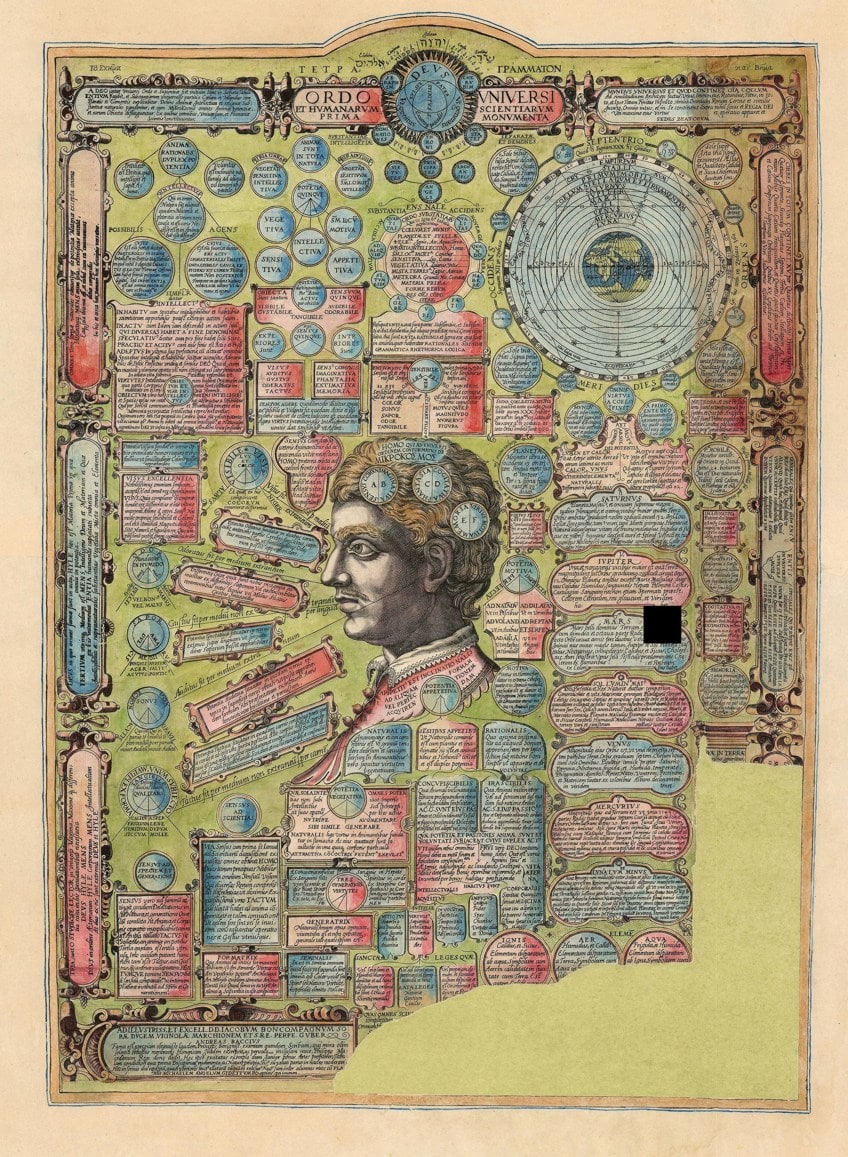 Diagram of Humanist Cosmography, 1585;Gerard de Jode, Public domain, via Wikimedia Eatables
Diagram of Humanist Cosmography, 1585;Gerard de Jode, Public domain, via Wikimedia Eatables
As academics felt that humanism should allow people to speak their minds independently, this encouraged others to break abroad from religious conformity. Humanism emphasized the idea that man was key in his own universe, meaning that all human accomplishments in fine art, literature, and scientific discipline should be embraced wholeheartedly.
As humanism challenged Europeans to question their own function inside society, the role of the Roman Catholic church building was also questioned.
Instead of depending on the volition of God, humanists encouraged people to act according to their own capabilities in a diverseness of areas. With the Renaissance developing, many more than people had learned how to read, write, and therefore translate ideas. This gave individuals a chance to accept their ain vocalism heard, every bit it led to them closely examining and critiquing religion as they knew information technology.
 Six Tuscan Poets (1659) by Giorgio Vasari, featuring Humanists (from left to correct) Dante Alighieri, Giovanni Boccaccio, Petrarch, Cino da Pistoia, Guittone d'Arezzo, and Guido Cavalcanti;Giorgio Vasari, Public domain, via Wikimedia Commons
Six Tuscan Poets (1659) by Giorgio Vasari, featuring Humanists (from left to correct) Dante Alighieri, Giovanni Boccaccio, Petrarch, Cino da Pistoia, Guittone d'Arezzo, and Guido Cavalcanti;Giorgio Vasari, Public domain, via Wikimedia Commons
Something that helped in the evolution of humanism was the cosmos of the printing press by Johannes Gutenberg around 1450. The introduction of a mobile printing press went on to transform advice and publication in Europe, as it allowed ideas to be spread at a rapid rate.
As a result, texts like the Bible were easily generated and distributed amid society, which marked the first time that most individuals read the Bible themselves.
The Medici Family Were Major Patrons of the Motility
One of the richest and most important families to come from Florence during the Renaissance period was the Medici family unit. Rising to power every bit the movement began, they were ardent supporters of the Renaissance and funded the majority of the art and architecture that prospered under their rule. Through the Medici'southward committee of The Portinari Altarpiece by Hugo van der Goes in 1475, they helped innovate oil painting to Italian republic, which went on to go the norm in subsequent Renaissance paintings that were produced.
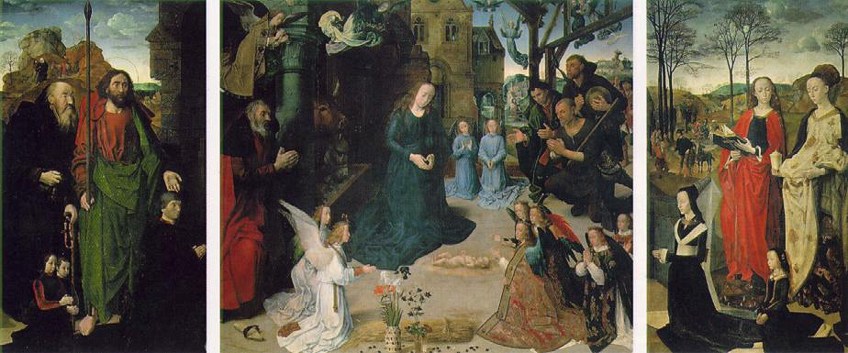 The Portinari Altarpiece (c. 1475) past Hugo van der Goes, commissioned past the Medici family unit;Hugo van der Goes, Public domain, via Wikimedia Commons
The Portinari Altarpiece (c. 1475) past Hugo van der Goes, commissioned past the Medici family unit;Hugo van der Goes, Public domain, via Wikimedia Commons
As the Medici family unit governed Florence for over lx years, their involvement within the Renaissance was truly remarkable. Famously backing the artistic style, they encouraged many outstanding Italian writers, politicians, artists, and other creatives to participate in a move they branded as an "intellectual and artistic revolution", the likes of which they did not experience during the Night Ages.
The Height of the Renaissance Was Called the "High Renaissance"
The term "High Renaissance" was used to denote the period that was considered to exist the height of the unabridged Renaissance movement, every bit it produced the most notable artworks during this time. Some of the most iconic artists to come from the whole Renaissance flow were said to accept emerged from the Loftier Renaissance era specifically.
These great artists included Leonardo da Vinci, Michelangelo, and Raphael, who were known every bit the holy trinity of Renaissance painters.
Three of the almost well-known and celebrated paintings and sculptures in history were produced by these three artists during the Loftier Renaissance, namely: Statue of David (1501 – 1504) by Michelangelo, Mona Lisa (1503) past da Vinci, and The Schoolhouse of Athens (1509 – 1511) past Raphael. Known to be a time of exceptional creative production, the High Renaissance lasted for virtually 35 years between the early 1490s to 1527.
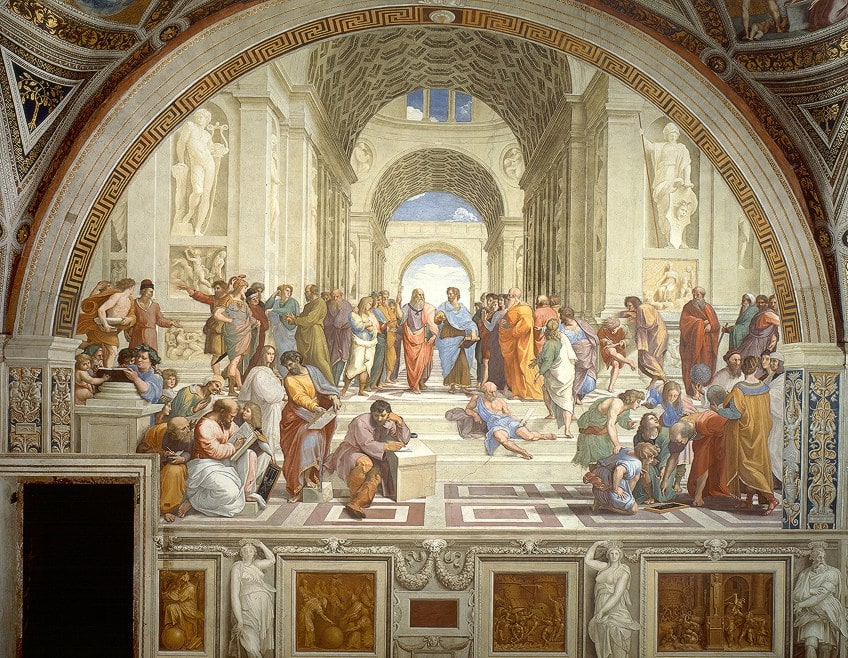 The Schoolhouse of Athens (1509-1511) by Raphael, fresco at the Raphael Rooms, Apostolic Palace, Vatican City;Raphael, Public domain, via Wikimedia Eatables
The Schoolhouse of Athens (1509-1511) by Raphael, fresco at the Raphael Rooms, Apostolic Palace, Vatican City;Raphael, Public domain, via Wikimedia Eatables
Paintings, Drawings, and Sculptures Were the Main Art Forms That Emerged
When looking at the kind of art that was created, Renaissance artists typically chose to depict, paint, and sculpt extraordinarily realistic and three-dimensional figures. This was considering artists ofttimes studied the man body in considerable detail and were able to accurately reflect their noesis in their artworks.
It was a well-known fact that da Vinci and Michelangelo used to frequently dissect cadaver bodies before creating their remarkable artworks.
This was done and then that they were able to learn how to improve sculpt and describe human being bodies and muscles precisely. However, it was illegal at the time for anyone who was not a doc to dissect bodies, which begs the question as to how they were immune to do so. Despite this morally greyness expanse, these two artists proved to exist the just ones who could sculpt and describe people so beautifully.
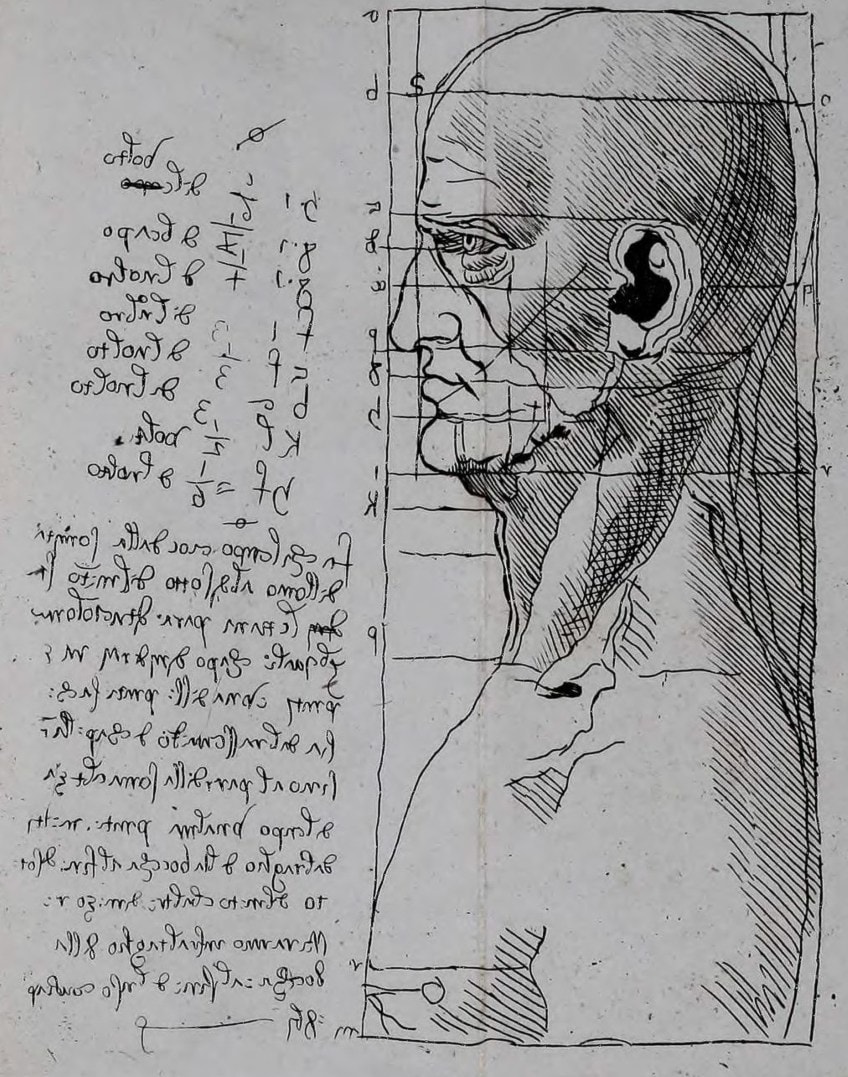 An anatomical study by Leonardo da Vinci, from Historical memoirs on the life, studies, and works of Leonardo da Vinci, 1804; Carlo Amoretti, Public domain, via Wikimedia Eatables
An anatomical study by Leonardo da Vinci, from Historical memoirs on the life, studies, and works of Leonardo da Vinci, 1804; Carlo Amoretti, Public domain, via Wikimedia Eatables
Leonardo da Vinci Was Viewed as the Ultimate "Renaissance Man"
Perhaps the most important creative person and polymath to come from the Renaissance menses was Leonardo da Vinci. While he is mainly known for producing the Mona Lisa (1503), which is widely regarded as the most famous oil painting of all time, da Vinci was dubbed as the quintessential "Renaissance man" during his lifetime.
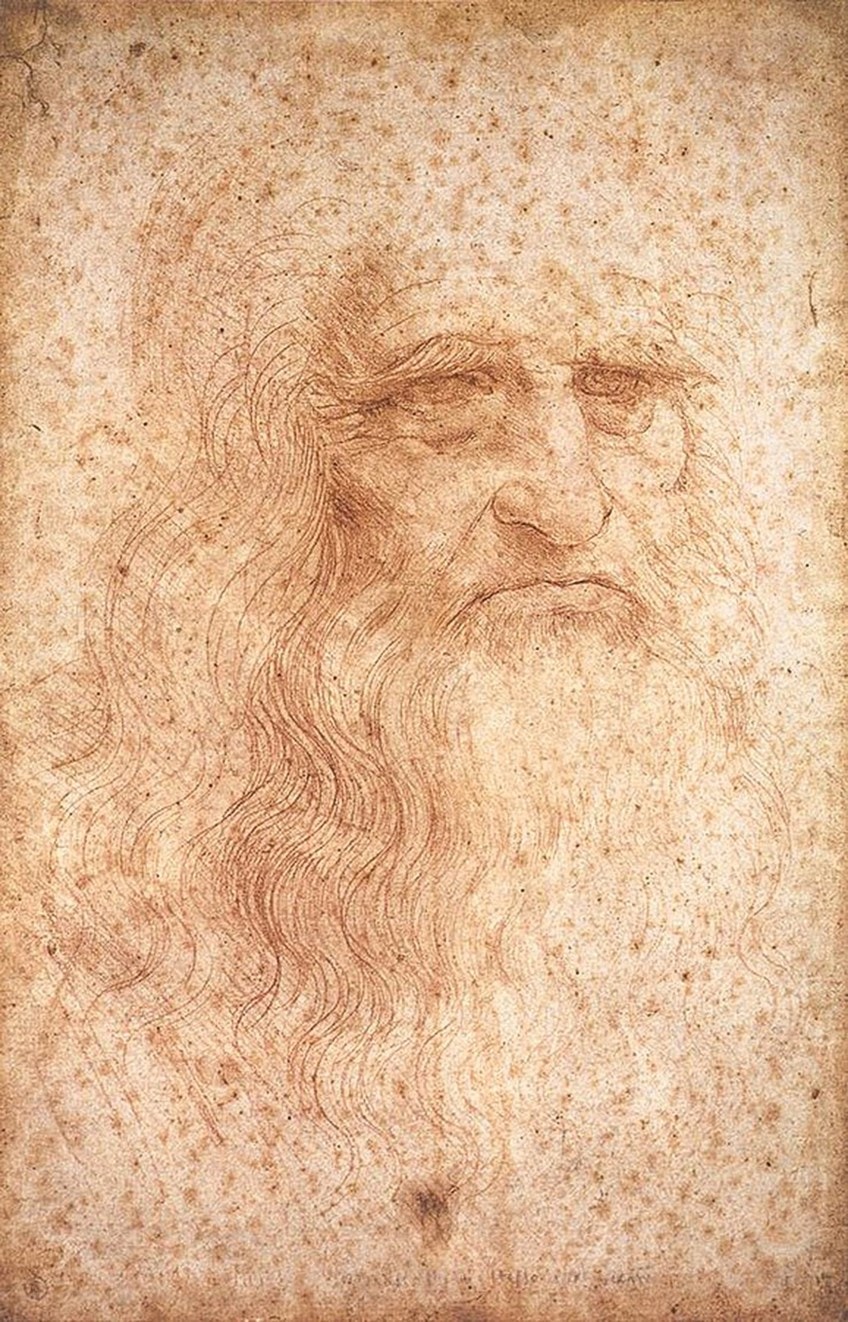 Supposed cocky-portrait of Leonardo da Vinci, c. 1512;Leonardo da Vinci, Public domain, via Wikimedia Commons
Supposed cocky-portrait of Leonardo da Vinci, c. 1512;Leonardo da Vinci, Public domain, via Wikimedia Commons
The championship of "Renaissance human" was given to da Vinci every bit he was said to display an avid curiosity in all areas of advocacy inside the Renaissance. His wide range of interests included painting, sculpture, drawing, architecture, human anatomy, engineering science, and science. While his reputation as a painter and draftsman was just based on certain notable works like the Mona Lisa, The Last Supper (1498), and Vitruvian Homo (c. 1490), he likewise created many important inventions that went on to revolutionize history.
Some of the most historic inventions by da Vinci that forever changed history included: the parachute, the diving adjust, the armored tank, the flying machine, the auto gun, and the robotic knight.
The Renaissance Lasted for Four Centuries
By the end of the 15th century, several wars had aggravated the Italian peninsula, with many invaders competing for territory. These included Spanish, French, and German intruders who all battled for the Italian commune, which led to much turmoil and volatility within the region. Trade routes had also inverse subsequently Columbus' discovery of the Americas, which led to an interval of economical downturn that severely restricted the finances that wealthy sponsors had available to spend on the arts.
Past 1527, Rome was attacked past the Spanish army under the reign of Rex Philip II, who went on to afterwards dominion the country. Italy remained threatened by other countries, such every bit Frg and France, and because of this, the Renaissance began to quickly lose momentum.
The High Renaissance period besides came to an end by 1527 after more than 35 years of popularity, which marked the true conclusion of the Renaissance equally a unified historical period.
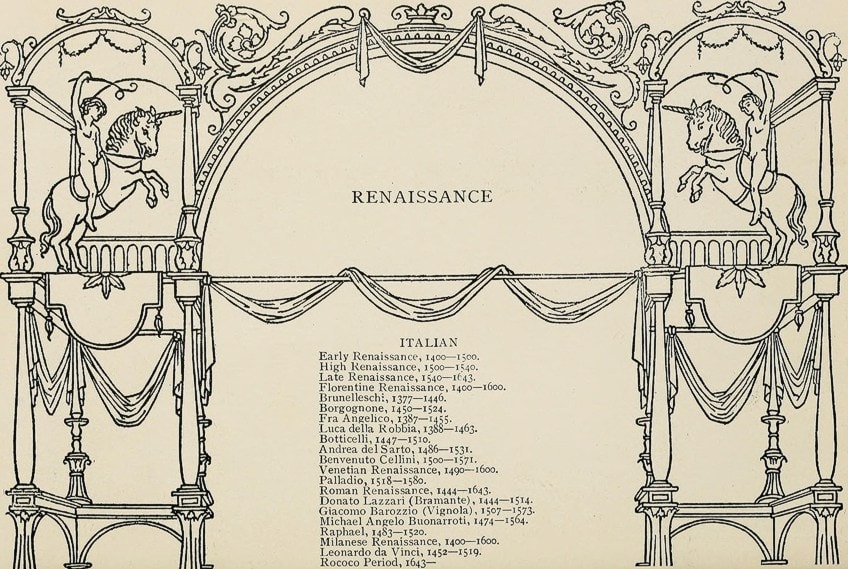 The unlike periods of the Italian Renaissance, 1906;Cyberspace Archive Book Images, No restrictions, via Wikimedia Commons
The unlike periods of the Italian Renaissance, 1906;Cyberspace Archive Book Images, No restrictions, via Wikimedia Commons
As a result of the Reformation that had emerged in Federal republic of germany, which disputed the values of the Catholic church, these churches faced a real trouble in Italy. In response to this predicament, the Catholic church initiated the Counter-Reformation which worked to censor artists and writers post-obit the Protestant Reformation. The Cosmic church building set up Inquisition and arrested every individual who dared challenge their doctrines.
Guilty people included Italian academics, artists, and scientists. Many Renaissance thinkers were afraid of being too outspoken, which concluded up suppressing their creativity. Nonetheless, their fright was valid, every bit their contestation was suddenly seen as an act punishable by expiry under the Cosmic church. This led to the majority of artists discontinuing their Renaissance ideas and artworks.
By the 17th century, the movement had completely died out and had been replaced by the Historic period of Enlightenment.
The Term "Renaissance" Was French
When looking at the interesting Renaissance history, it is clear to run into that the move encompassed a resurgence of the ideas and values of classic antiquity. In all essence, the Renaissance era signaled the end of the Middle Ages and went ahead in introducing a completely different way of thinking and doing things.
Withal, when wondering the question, "what does Renaissance mean?", it can simply be understood by looking at its name. Taken from the French language, the give-and-take "renaissance" directly translates to "rebirth", which was merely seen in the English linguistic communication around the 1850s.
 Definitions from Oxford Languages
Definitions from Oxford Languages
A rebirth is exactly what happened in terms of the restoration that occurred of ancient Greek and Roman scholarship and values. Those credited with launching the Renaissance movement were trying to accurately recreate classical models from these ii cultures.
Despite this being the only acceptable term that has always been used for the movement, some scholars have stated that the give-and-take "Renaissance" was too vague to encapsulate all that occurred.
Additionally, the term "Renaissance years" was also believed to not be knowledgeable and aware enough to fairly capture all that was discovered and developed during the motility. Those with opposing views of the movement have said that the Renaissance was more correctly a part of a "Longue Durée" of European history.
The Renaissance Is Regarded as the Most Important Art Motility to Occur
The Renaissance proved to be a period of revolutionary explorations in a variety of disciplines. Certain discoveries afforded the movement much popularity, with artists and other creatives going on to produce truly incredible works that are still spoken about today. When asking yourself, "why is the Renaissance important?", the answer to this question is fairly simple.
This movement proved to exist one of the most significant periods ever considering of the great strides that were made in fine art and science at the time.
 Iv Renaissance illustrations showing mathematic calculations and their problems; See page for author, CC BY 4.0, via Wikimedia Commons
Iv Renaissance illustrations showing mathematic calculations and their problems; See page for author, CC BY 4.0, via Wikimedia Commons
The spread of the Renaissance also happened relatively quickly, which demonstrated the movement'southward importance. Expanding to other Italian cities at beginning, like Venice, Milan, Rome, Bologna, and Ferrara, the Renaissance before long influenced neighboring countries across Northern Europe by the time the 15th century appeared. Although other countries would take encountered the Renaissance later than Italian republic, the impacts and advancements that happened in these countries were notwithstanding groundbreaking.
Art, Architecture, and Science That Developed
One of the main reasons that the Renaissance developed out of Italy and not any other European country was considering Italia was extremely wealthy at the fourth dimension. Subsequently the Blackness Death, where many individuals died, a big gap was left in society.
This allowed survivors with relatively more wealth and ability to begin climbing the social ladder, which in turn made these individuals more willing to spend their money on things like art and music.
As the Renaissance had wealthy backers to finance individuals in the creation of art, literature, music, and scientific inventions, the movement grew rapidly. Science, in particular, took giant strides in terms of its advocacy, as the Renaissance era embraced chemical science and biology in place of Aristotle's natural philosophy.
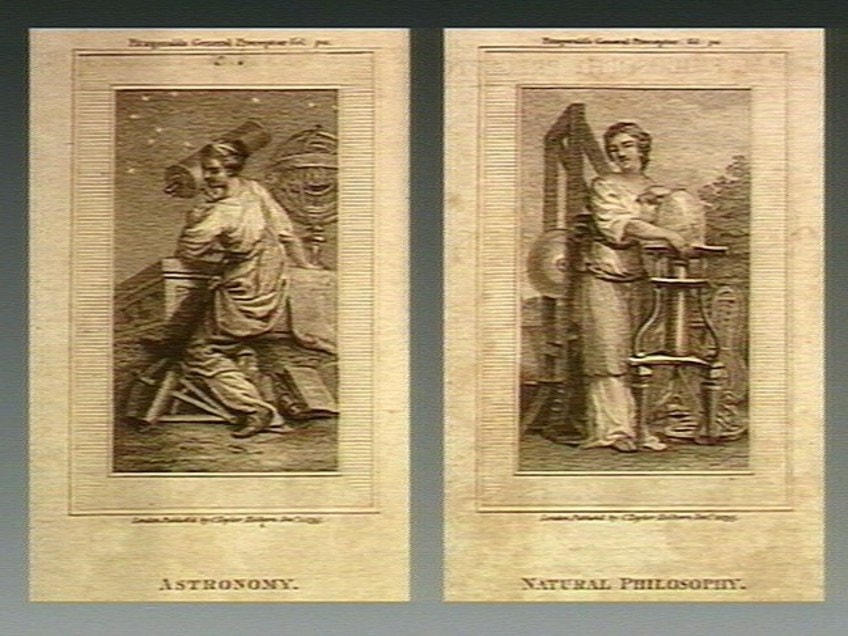 18th-century engraving of the personification of Astronomy and Natural Philosophy;Run into page for author, CC By 4.0, via Wikimedia Commons
18th-century engraving of the personification of Astronomy and Natural Philosophy;Run into page for author, CC By 4.0, via Wikimedia Commons
The aspects of art, architecture, and science were very closely connected during the Renaissance, as it was a rare time in history where all of these different fields of study were able to join together quite easily. Leonardo da Vinci exists as the perfect example of all of these genres coming together.
He was known to boldly incorporate various scientific principles, such as his written report of anatomy, into his artworks so that he could paint and draw with absolute precision.
 The Virgin and Child with Saint Anne (c. 1503) by Leonardo da Vinci;Leonardo da Vinci, Public domain, via Wikimedia Commons
The Virgin and Child with Saint Anne (c. 1503) by Leonardo da Vinci;Leonardo da Vinci, Public domain, via Wikimedia Commons
Standard subject matters seen in Renaissance art were religious images of the Virgin Mary and ecclesiastical rituals. Artists were usually commissioned to describe these spiritual scenes in churches and cathedrals. An important development to occur in art was the technique of drawing accurately from human life.
Fabricated popular by Giotto di Bondone, who bankrupt abroad from the Byzantine style to innovate a new technique of presenting human bodies in frescoes, he is viewed every bit the beginning great artist who contributed to Renaissance history.
The Renaissance Geniuses Included Art History's Virtually Famous Artists
As a period of rapid development, the Renaissance was dwelling to some of the most renowned and revolutionary artists, writers, scientists, and intellectuals. Among others, the about notable examples of Renaissance artists were Donatello (1386 – 1466), Sandro Botticelli (1445 – 1510), Leonardo da Vinci (1452 – 1519), Michelangelo (1475 – 1564), and Raphael (1483 – 1520).
Other Renaissance prodigies included philosopher Dante (1265 – 1321), writer Geoffrey Chaucer (1343 – 1400), playwright William Shakespeare (1564 – 1616), astronomer Galileo (1564 – 1642), philosopher René Descartes (1596 – 1650), and poet John Milton (1608 – 1674).
 5 Famous Men of the Florentine Renaissance (c. 1450) by Paolo Uccello, featuring (from left to correct) Giotto, Paolo Uccello, Donatello, Antonio Manetti, and Filippo Brunelleschi; Paolo Uccello, Public domain, via Wikimedia Commons
5 Famous Men of the Florentine Renaissance (c. 1450) by Paolo Uccello, featuring (from left to correct) Giotto, Paolo Uccello, Donatello, Antonio Manetti, and Filippo Brunelleschi; Paolo Uccello, Public domain, via Wikimedia Commons
The Well-nigh Famous Paintings Are Yet Viewed Today
A handful of the near famous artists who e'er lived came from the Renaissance catamenia, as well every bit their still-revered artworks. These include Mona Lisa (1503) and The Last Supper (1495 – 1498) by Leonardo da Vinci, Statue of David (1501 – 1504) and The Cosmos of Adam (c. 1512) by Michelangelo, every bit well as The Birth of Venus (1485 – 1486) by Sandro Botticelli.
Some Accept Stated that the Renaissance Did Not Fifty-fifty Happen
While the majority have viewed the Renaissance to be an extraordinary and impressive time in European history, some scholars accept claimed that the period was actually non that different from the Middle Ages. If nosotros look at the dates, the Middle Ages and the Renaissance overlapped much more than than traditional accounts would have you believe, as a lot of center ground existed between the ii eras.
While the precise timing and general impact of the Renaissance are sometimes contested, there is piffling argument about the impact of the events of the flow. Ultimately, the Renaissance led to developments that contradistinct the fashion people comprehended and deciphered the world around them.
Some controversy nonetheless exists on whether the entire Renaissance period actually existed or not.
 A decorative drawing representing the Renaissance; Cyberspace Archive Book Images, No restrictions, via Wikimedia Eatables
A decorative drawing representing the Renaissance; Cyberspace Archive Book Images, No restrictions, via Wikimedia Eatables
Some critics have pointed out that most of Europe'south population did not undergo any big changes in their lifestyles or experience whatever intellectual and cultural upheaval during the Renaissance. This suggested that the menses could not have been that of import, as nothing made that big of an touch on on their lives.
The bulk of society continued to live their ordinary lives on farms, as the refined fine art and learning from the cities did not accomplish them.
If we choose to accept the side of the cynics, answering the question "when did the Renaissance finish?" becomes much easier as it maybe never existed in the commencement place. As many unfavorable social factors were associated with the Medieval menses, such as war, poverty, and religious persecutions, nearly of society was more concerned about those pressing issues than that of the Renaissance.
Linear Perspective Was the About Important Invention of the Movement
One of the almost pregnant progressions in Renaissance art was the introduction of linear perspective. Developed effectually 1415 by Florentine architect and engineer Filippo Brunelleschi, linear perspective fabricated use of mathematical principles to realistically depict space and depth in art. Brunelleschi accompanied sculptor Donatello on a trip to Rome to study ancient Roman ruins, which was something that no ane had tried to practise in such particular until then.
Linear perspective eventually led to realism, which was the core feature seen within all Renaissance artworks.
The Church Financed Great Renaissance Artworks
Since the church building regularly gave out huge commissions for artwork, Rome almost went broke! Equally the church proved to be 1 of the biggest financial supporters of most of the artworks made throughout the Renaissance, they went on to tax Christians throughout Europe.
This was done so that they could raise funds for the large commissions. These payments straight financed some iconic masterpieces that people travel from all over the world to see today, such as Michelangelo's ceiling paintings at the Sistine Chapel.
 A section of the ceiling of the Sistine Chapel, painted by Michelangelo from 1508 to 1512;Fabio Poggi, CC BY 3.0, via Wikimedia Eatables
A section of the ceiling of the Sistine Chapel, painted by Michelangelo from 1508 to 1512;Fabio Poggi, CC BY 3.0, via Wikimedia Eatables
A Great Rivalry Existed Between Michelangelo and Leonardo da Vinci
Two of the Renaissance's greatest artists, Leonardo da Vinci and Michelangelo, were in fact keen rivals throughout their careers. Despite being highly respected and admired in their own correct, they were fiercely competitive with one another and heavily criticized each other's work.
This feud between them began in the early 16th century when both da Vinci and Michelangelo were employed to pigment immense battle scenes on the same wall of the Council Hall in the Palazzo Vecchio in Florence.
At the time of the commission in 1503, da Vinci was in his early 50s and was already greatly revered all over Europe. However, as Michelangelo was considered to be a prodigy, he was commissioned to paint the same wall just a yr later, at the tender age of 29.
This commission came after Michelangelo's iconic statue David was revealed and despite da Vinci'due south ain fame and talent, he suddenly plant a rival in the fine art world. Michelangelo was also known to accept made fun of da Vinci once for his failure to complete a sculpture of a horse.
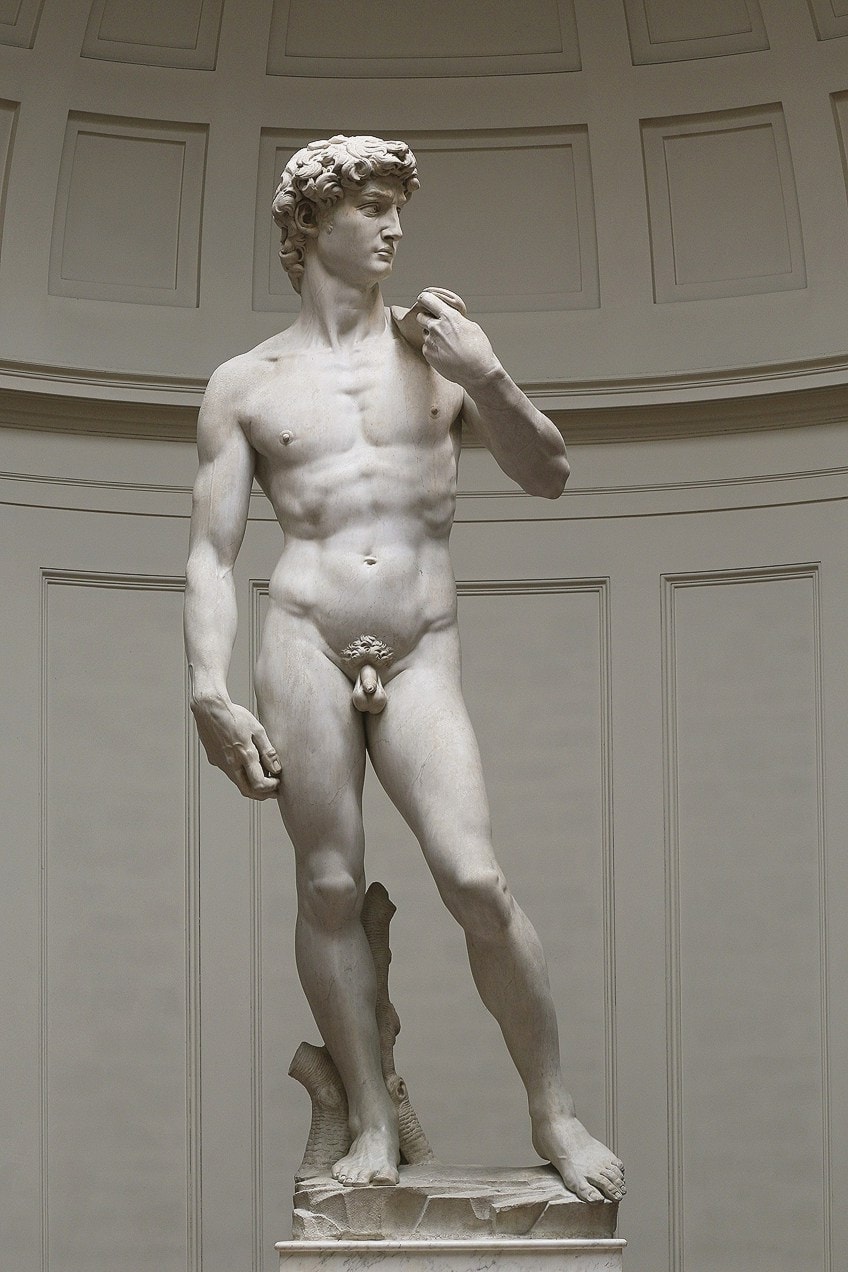 David (1501-1504) past Michelangelo;Michelangelo, CC BY iii.0, via Wikimedia Commons
David (1501-1504) past Michelangelo;Michelangelo, CC BY iii.0, via Wikimedia Commons
The Renaissance Was Not Always as Wonderful equally History Suggests
The Renaissance was non e'er the "Gilded Era" of advocacy and progress that historians take fabricated it out to be. The bulk of people who were alive during the Renaissance did non fifty-fifty view information technology to be something infrequent. At the time, the flow nevertheless endured very crucial bug such equally religious wars, political corruption, inequality, and even witch-hunts, which took focus over the developments that were happening in the arts and sciences.
Surviving for over three centuries, at that place is no denying just how significant the Renaissance catamenia was in terms of its revolutionary developments and advancements in both world and art history. Many of the near prolific artists and artworks to ever be made come from the Renaissance, whose touch on upon the fine art globe is nevertheless discussed today. If you accept enjoyed reading up almost these Renaissance facts, nosotros encourage yous to accept a look at our other Renaissance fine art pieces also.
Frequently Asked Questions
What Is the Most Valuable Painting From the Renaissance?
Many people will hold that the most valuable painting to come from the Renaissance menstruation is Leonardo da Vinci'due south Mona Lisa, which he painted in 1503. Mona Lisa is actually thought to be the most important painting ever fabricated, with over 10 million people traveling to view the artwork in the Louvre Museum in Paris each year.
What Is the Most Valuable Sculpture From the Renaissance?
The greatest sculptor to come from the Renaissance menses was fabricated by Michelangelo Buonarroti, the greatest sculptor to ever live. Information technology makes sense that ane of his artworks is viewed as the virtually valuable sculpture from the motility. David, which was carved between 1501 and 1504, is without question the most famous sculpture in existence. Located at the Galleria dell 'Accademia in Florence, Rome, David attracts more than eight million visitors a year.
Source: https://artincontext.org/renaissance-facts/
0 Response to "What Influenced Art During the Renaissance What Affected Art During the Renaissance"
Post a Comment